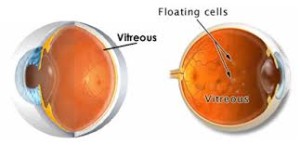It Can Be Frightening to See Small Floaters, Specks or Flashes of Light. But Should You Be Concerned if You Do?
Have you ever spotted a small speck, dot, or squiggle appearing to float in the air in front of you, only to have it move away when you tried to look at it directly? Maybe you’ve noticed flashing lights like fireworks or lightning streaks that you knew couldn’t be there? If so, you’ve joined those who have experienced the common visual phenomenon known as eye floaters and flashes. Flashes and floaters are an age-related change in the eyes that often occurs in the fourth decade of life, but sometimes earlier in people who have a long history of coughing or sneezing frequently.
Most people — 8 out of every 10, in fact — will experience eye floaters and flashes at some point in their lives. They are a normal part of the aging process and most of the time not considered a medical problem. However, the rapid onset of multiple eye floaters and flashes could indicate that a tear in the retina has occurred; if not treated immediately, this could lead to loss of sight.
Eye floaters occur when the gel that fills the inside of the eye, known as Vitreous, dehydrates and shrinks due to aging and loss of function of the cells inside the eye which produce it, causing condensates to form in the gel. These particles block the light passing through your eye, casting shadows on the retina. The shadows are perceived as floaters, which can be created by:
- The formation of glycoprotein clumps in the vitreous gel. These types of eye floaters tend to look like spots, squiggles, lace, cobwebs, or circles. They remain in the vitreous gel permanently, but people tend to ignore them as they shrink and contract over time.
- The rupture of blood vessels in the retina as the shrinking vitreous gel pulls on them. Eye floaters caused by this kind of minor hemorrhaging create larger black spots or blobs in your field of vision, which can resemble ink blots, smoke or a cloud of gnats. They usually resolve themselves as the blood is reabsorbed by the body, but can last for months or years if very large.
Posterior Vitre ous Detachment (PVD)
ous Detachment (PVD)
In youth and early adulthood the eye is essentially filled with vitreous, which is directly apposed to the retina, the inner lining of the posterior eye that serves the function of transposing light into electrical signals which are sent to the brain via the optic nerve. The vitreous gel can actually peel off or pull away from the retina, a condition known PVD. Debris formed from the condensed vitreous detachment drifts in the vitreous gel and causes floaters that may resemble cobwebs, mist, or veils that obscures part of your field of vision. In most cases, the vitreous detachment occurs cleanly and the eye floaters become less noticeable after a few months.
Eye flashes result from thickened vitreous gel that remains stubbornly adherent to the retina, pulling and tugging on it. As the retina has no pain fibers and can only transduce light into electrical impulses, the energy imparted on the retina by the tugging vitreous is incorrectly interpreted as light flashes, causing visual effects that look like lightning streaks or light flickers. These flashes may appear off and on for a few weeks or months, but normally resolve over time. If you see flashes accompanied by floaters, you most likely are experiencing PVD.
Flashes also can be caused by an evolving migraine headache. In these instances, the eye flashes often will look like jagged lines or heat shimmers that last between 10 and 20 minutes. Occasionally, the migraine visual symptoms can occur without an accompanying headache, a condition known as ophthalmic migraine.
Time is the Best Treatment for Floaters and Flashes
Floaters caused by the condensing of vitreous are most visible when you are looking at a plain, light-colored background or when outdoors in bright sunlight. Close one of your eyes and look at an empty wall, a blue sky, or a white background on a computer screen. If you see a squiggle, dot, or other shape flitting around, then you have found an eye floater. Flashes often are noticed at night or in low light illumination, and when one coughs, sneezes or moves their head rapidly.
Eye floaters and flashes normally require no treatment. Flashes usually fade away, and over time most people don’t notice floaters as often because the brain learns to filter out the visual interference. An annoying floater in the center of your vision sometimes can be relieved by rolling your eyes around, which swirls the vitreous gel in the eyeball and gets the floater to move away.
A surgical procedure called vitrectomy removes the vitreous gel from the eye and replaces it with saline solution, but it is major eye surgery that is generally not considered worth the risk.
When Retinal Detachment Occurs
The tugging of the vitreous gel on the retina can sometimes cause a more serious medical condition in which the retina tears and detaches from the eye. If this occurs, you could partially or completely lose your vision in that eye. Symptoms of retinal detachment include:
- A sudden large increase in the number of eye floaters and flashes you are experiencing, or large ink blot-like floaters, or the sudden appearance of these for the first time.
- Loss of your peripheral vision, usually appearing like a curtain or shadow that moves toward the center of your vision over time.
- Vision that has become blurred or distorted.
Surgery is the only treatment for retinal detachment, and time is of the essence in preserving your vision. If you are experiencing any of these symptoms, you should call our office immediately.
Comments are closed